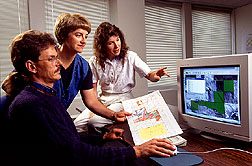GPFARM Software Foresees the Future
For the first time, Great Plains farmers and ranchers will have an electronic crystal ball to foresee consequences of their management decisions.
"Our new computer program will give farmers and ranchers new insight stretching ahead as much as 10 or 20 years into the economic and environmental effects of what they plant, when and how much they fertilize, and the form of conservation tillage they practice," says Agricultural Research Service soil scientist Lajpat R. Ahuja.
The new software, a decision support system, is named "GPFARM" short for Great Plains Framework for Agricultural Resource Management.
Ahuja heads the team of ARS researchers that developed GPFARM at Fort Collins, Colorado. Ahuja's ARS colleagues include hydraulic engineer James C. Ascough, II, soil scientist Marvin J. Shaffer, range scientist Jonathan D. Hanson, and several support staff.
They devised the program in collaboration with agricultural economist Dana L. Hoag at Colorado State University.
Version 1.0 of GPFARM should be released sometime this fall. Ahuja says it will be the first agricultural decision support system of its kind designed to run under the Microsoft Windows 95 operating system. Simulation results are displayed as narrative text, tables, and graphs. A typical desktop computer can run GPFARM for an average farm or ranch in 30 minutes or less.
Earlier this year, the scientists beta-tested a prototype with about 30 farmers, agricultural consultants, and personnel at other USDA agencies.
Beta-tester Bill Gilbert has worked for 18 years as a consultant to over 35 farmers in the Fort Collins area. "GPFARM should lead to better decisions economic as well as environmental on a host of variables like applying water, fertilizers, and pesticides," he says.
"GPFARM will allow managers to design and compare alternative strategies on the computer before implementing them in the field," Ahuja says. The program has built-in databases for soils, land use, climate, chemicals, and standard farm management practices. In addition, users provide specific data about farm or ranch soil conditions, as well as their own management practices.
Then GPFARM simulates biological, chemical, and physical interactions between soils, crops, animals, and climate. The interactions lead to customized management decisions. GPFARM also simulates how decisions affect soil productivity, animal production, soil erosion, and quantities of nitrate and pesticides leached from soil.
"The program even takes into account factors affecting long-term sustainability for economic and environmental factors," Ahuja says. Examples include loss of soil productivity due to erosion, changes in soil organic matter content, and degradation of groundwater quality and supply.
"We have been fine-tuning and resolving over 200 comments and suggestions from the beta-testers," he notes. "As a result, we have made the program easier to use by modifying its look on the screen and improving the ways in which users enter the data and display the simulations. We also strengthened the program's capacity to simulate the growth of irrigated crops," says Ahuja.
Future versions of GPFARM will use geographic information system (GIS) technology a computerized approach to storing and analyzing geographic data. GIS will allow users to evaluate environmental effects on and off the farm of runoff, chemical seepage, and erosion. It will also allow gauging the off-site fate of each chemical leached. By Hank Becker, Agricultural Research Service Information Staff.
Lajpat R. Ahuja is in the USDA-ARS Great Plains Systems Research Unit, P.O. Box E, Fort Collins, CO 80522; phone (970) 490-8315, fax (970) 490-8310.
GPFARM will be available free of charge either on CD-ROM or via downloading from the lab's web site at www.gpsr.colostate.edu/GPSR/
"GPFARM Software Foresees the Future" was published in the November 1998 issue of Agricultural Research magazine. Click here to see this issue's table of contents.







